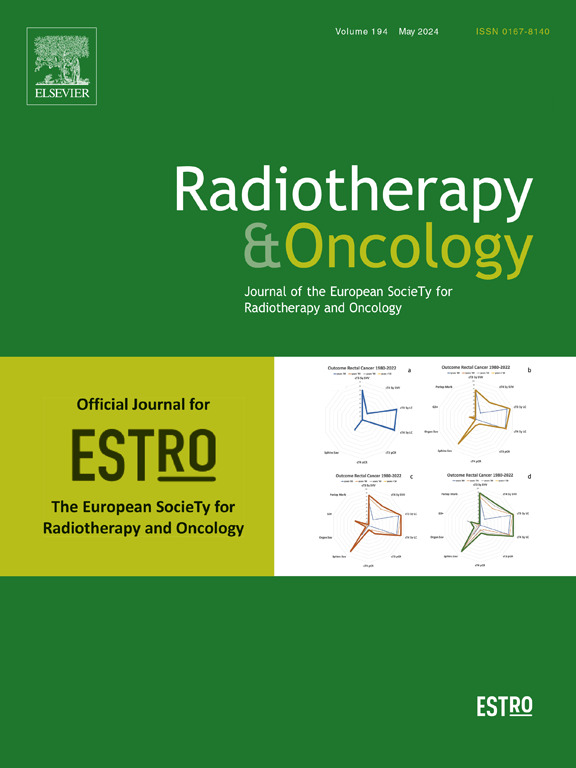基于PET和CT的DenseNet在口咽癌预后预测方面优于先进的深度学习模型。
IF 4.9
1区 医学
Q1 ONCOLOGY
引用次数: 0
摘要
背景:在HECKTOR 2022挑战集[1]中,引入了几种最先进的(SOTA,达到最佳性能)深度学习模型,用于使用PET和CT图像预测头颈癌患者的无复发期(RFP)。目的:本研究探讨传统的DenseNet架构,通过优化层数和图像融合策略,是否可以达到与SOTA模型相当的性能。方法:HECKTOR 2022数据集包括来自7个不同中心的489名口咽癌(OPC)患者。随机分为训练集(n = 369)和独立测试集(n = 120)。此外,在我们中心接受化疗(放疗)的400名OPC患者的额外数据集被用于外部测试。每位患者的数据包括治疗前的CT和pet扫描,人工生成的原发肿瘤和淋巴结的GTV(大体肿瘤体积)轮廓,以及RFP信息。本研究将DenseNet与基于HECKTOR 2022数据集开发的三种SOTA模型的性能进行了比较。结果:采用早期融合方法(将CT、PET和GTV视为不同的输入通道)输入CT、PET和GTV时,DenseNet81(共81层)获得的内部测试c指数为0.69,与SOTA模型的性能指标相当。值得注意的是,从输入数据中去除GTV后,内部测试C-index仍然为0.69,而将外部测试C-index从0.59提高到0.63。此外,与仅使用PET的模型相比,当使用CT和PET的后期融合(提取特征的连接)时,DenseNet81在内部和外部测试集上的c指数分别为0.68和0.66,而仅在内部测试集上使用早期融合则更好。结论:具有81层的基本DenseNet体系结构显示出与SOTA模型相当的预测性能,SOTA模型在内部测试集中具有更复杂的体系结构,在外部测试中具有更好的性能。CT和PET影像数据的后期融合在外部测试中表现优异。本文章由计算机程序翻译,如有差异,请以英文原文为准。
PET and CT based DenseNet outperforms advanced deep learning models for outcome prediction of oropharyngeal cancer
Background
In the HECKTOR 2022 challenge set [1], several state-of-the-art (SOTA, achieving best performance) deep learning models were introduced for predicting recurrence-free period (RFP) in head and neck cancer patients using PET and CT images.
Purpose
This study investigates whether a conventional DenseNet architecture, with optimized numbers of layers and image-fusion strategies, could achieve comparable performance as SOTA models.
Methods
The HECKTOR 2022 dataset comprises 489 oropharyngeal cancer (OPC) patients from seven distinct centers. It was randomly divided into a training set (n = 369) and an independent test set (n = 120). Furthermore, an additional dataset of 400 OPC patients, who underwent chemo(radiotherapy) at our center, was employed for external testing. Each patients’ data included pre-treatment CT- and PET-scans, manually generated GTV (Gross tumour volume) contours for primary tumors and lymph nodes, and RFP information. The present study compared the performance of DenseNet against three SOTA models developed on the HECKTOR 2022 dataset.
Results
When inputting CT, PET and GTV using the early fusion (considering them as different channels of input) approach, DenseNet81 (with 81 layers) obtained an internal test C-index of 0.69, a performance metric comparable with SOTA models. Notably, the removal of GTV from the input data yielded the same internal test C-index of 0.69 while improving the external test C-index from 0.59 to 0.63. Furthermore, compared to PET-only models, when utilizing the late fusion (concatenation of extracted features) with CT and PET, DenseNet81 demonstrated superior C-index values of 0.68 and 0.66 in both internal and external test sets, while using early fusion was better in only the internal test set.
Conclusions
The basic DenseNet architecture with 81 layers demonstrated a predictive performance on par with SOTA models featuring more intricate architectures in the internal test set, and better performance in the external test. The late fusion of CT and PET imaging data yielded superior performance in the external test.
求助全文
通过发布文献求助,成功后即可免费获取论文全文。
去求助
来源期刊

Radiotherapy and Oncology
医学-核医学
CiteScore
10.30
自引率
10.50%
发文量
2445
审稿时长
45 days
期刊介绍:
Radiotherapy and Oncology publishes papers describing original research as well as review articles. It covers areas of interest relating to radiation oncology. This includes: clinical radiotherapy, combined modality treatment, translational studies, epidemiological outcomes, imaging, dosimetry, and radiation therapy planning, experimental work in radiobiology, chemobiology, hyperthermia and tumour biology, as well as data science in radiation oncology and physics aspects relevant to oncology.Papers on more general aspects of interest to the radiation oncologist including chemotherapy, surgery and immunology are also published.
 求助内容:
求助内容: 应助结果提醒方式:
应助结果提醒方式:


